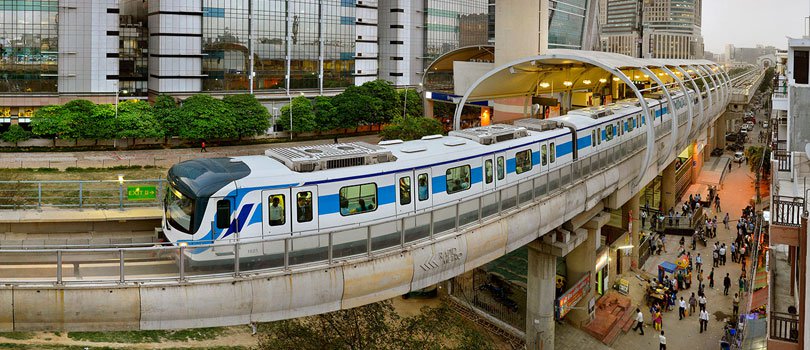In what can only be described as a remnant of misrule by the previous Haryana government, the Gurugram Rapid Metro has emerged as a monumental failure which no one wants to run any longer. As per an ET report, as the deadline (September 17) for the continuation of the Gurugram Rapid Metro approaches closer, speculations are flying around that Haryana Urban Development Authority (HUDA) will run the enterprise as the Rapid Metro Rail Gurgaon Ltd (RMGL) has expressed its inability to run the rapid transit system any longer.
It is important to mention here that DLF proposed the Gurugram metro project between Sikanderpur and NH8 in September 2007 to the Government of Haryana and with the consultancy services of IL&FS, prepared a Detailed Project Report (DPR) to be produced before the Haryana Government. The report claimed fantastical ridership potential, projecting expected traffic at 1 lakh riders per day from the first year of operation itself and about 2.2 lakh by 2015, but in reality, even till this day, the number has not crossed 50,000 per day. The whole basis of the project turned out to be fraudulent numbers at best, and DLF got itself a marvelous metro operating around its infrastructure. A Haryana government source told MoneyLife that DLF’s projects saw a cost appreciation of over 15% due to the metro, while the rest of the realty industry ailed globally. The controversial land deal between Robert Vadra and DLF, legitimised by the CM Hooda led Haryana government, could be the result of such a generous gift to DLF.
It should also be noted that the conception and approval of this expensive, elevated metro project was based on these fraudulent numbers. Banks were dragged into funding this project while the Bhupinder S. Hooda led Haryana Government granted right of way and land for the Gurugram metro line and stations for only a share in non-fare revenues and connectivity charges. The project was replete with absurdities. It even bore a cost overrun of about Rs. 675 crore, that is, from an estimated Rs. 325 Crore to about 1000 crores. Haryana Govt allowed this rise in project cost, and the question lies on whom among the IL&FS management and its subsidiaries benefited from the fees generated by this generous spike. Though DLF had pulled out of the joint venture, it had managed to benefit by obtaining metro connectivity to Gurugram through Cyber City, DLF Phase-2 and DLF Phase-3.
This is not the first time that the project has come in limelight for wrong reasons. It is relevant to mention here that in 2017, the Comptroller and Auditor General (CAG) had lambasted the HUDA over its failure to enforce terms of concession contract resulting in non-recovery of Rs. 1.57 Crore for delayed payment of connectivity charges and charging of excess passenger fares amounting to Rs. 11.84 crore, by RMGL.
Now, it seems that HUDA will have to manage this troubled public transport system and somehow manage to fix it. As per IANS, Gurugram residents see low ridership, high cost and poor location for the dismal state of the Rapid Metro. As per local residents, the operations of the Rapid Metro need to be taken towards Old Gurgaon which is in a dire need of public transport. Now, HUDA will have to work really hard towards the revival of the ridership of Rapid Metro and staging a turnaround as far as bringing its connectivity to the neglected areas is concerned.
The poor state of the Gurugram Rapid Metro can be inferred from the fact that about 60 per cent of the transit system’s revenue comes from advertisements. As opposed to this, only 39 per cent of its revenue comes from ridership. Therefore, the infrastructure project has failed in its core area. The failure of Rapid Metro is not limited to impractical routes but its revenue fares have also been affected by issues like non allocation of land for parking areas, absence of feeder services, no streamlining of routes for alternate modes, lack of integration with the comprehensive mobility plan for Gurugram, and so on. This reflects terrible planning and interestingly these features form a necessary part of the Metro Policy announced by the Government of India in August 2017.
The Rapid Metro is a living example of crony capitalism, poor planning and misrule of the previous regime. And now the present government is forced into handling this remnant of the previous government’s crony capitalism. This also shows how the crony capitalism and poor urban planning continues to affect government revenue and national economy. For several years, activists, including IAS officer Ashok Khemka, and political opponents of the Congress have been alleging a nexus between Robert Vadra, DLF and Haryana Government. The abject failure of Gurugram Rapid Metro is now likely to reignite such allegations.
